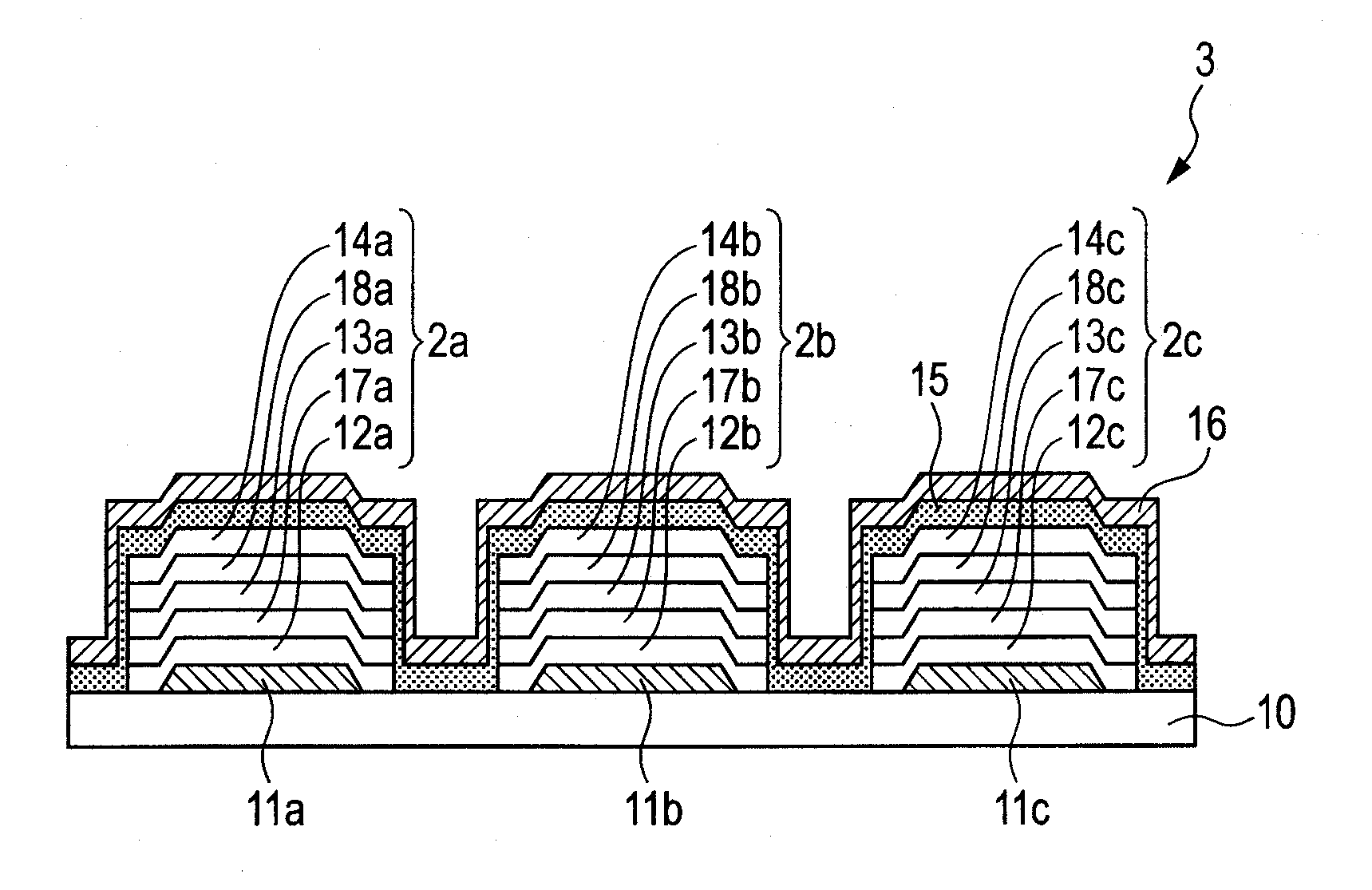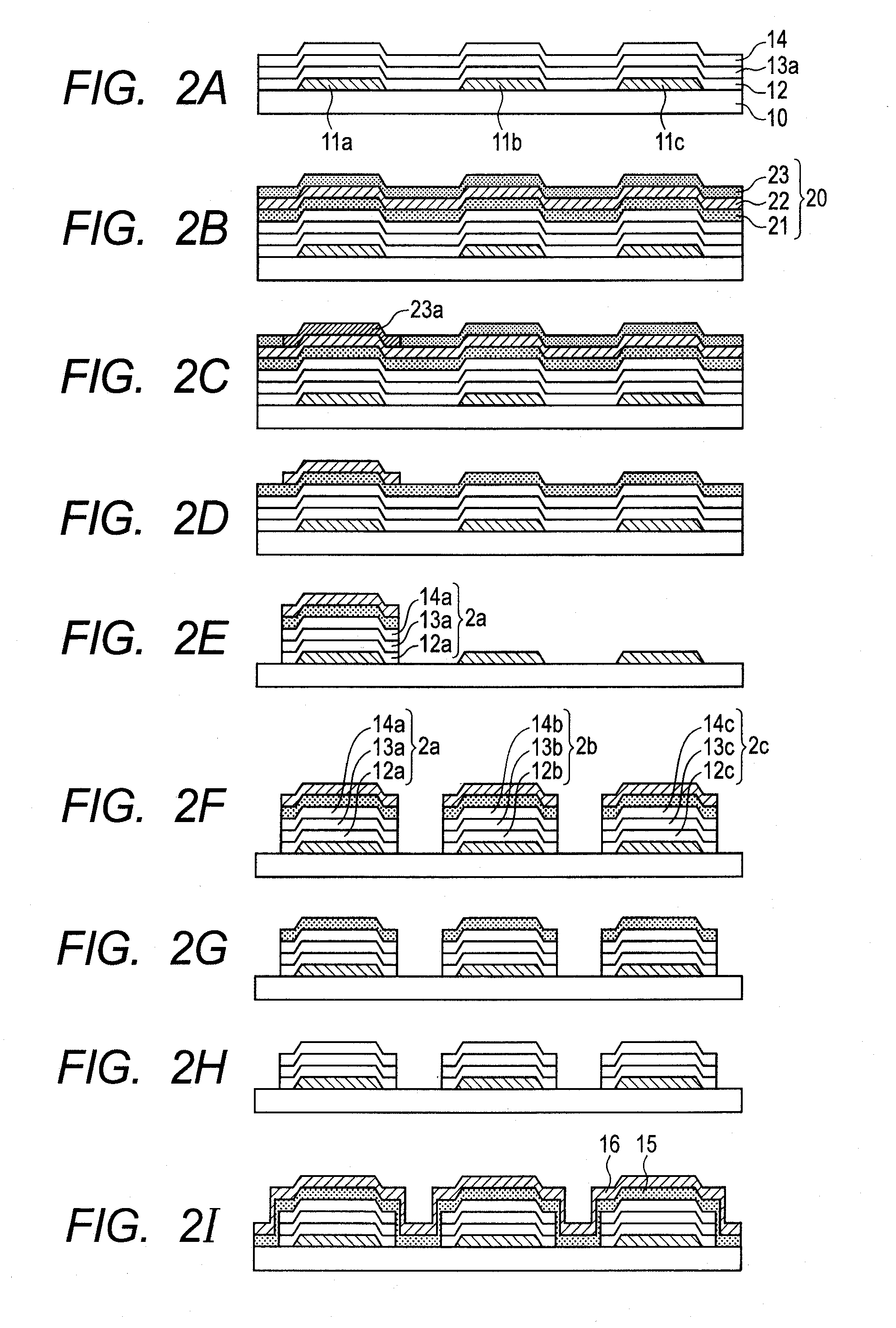Method of manufacturing organic electroluminescence display device
a technology of electroluminescence display and organic electroluminescence, which is applied in the direction of solid-state devices, chemical vapor deposition coatings, coatings, etc., can solve the problems of process accuracy, pixel size has a limit of about 100 m, and stress may deform the opening in the mask, etc., to achieve high-efficiency, long-life, and high-definition
- Summary
- Abstract
- Description
- Claims
- Application Information
AI Technical Summary
Benefits of technology
Problems solved by technology
Method used
Image
Examples
example 1
[0097]An organic EL display device 3 illustrated in FIG. 3 was manufactured according to manufacturing steps described in the following. Note that, in the organic EL display device 3 illustrated in FIG. 3, an electron blocking layer (17a, 17b, or 17c) is provided as an interposed layer between the hole transport layer (12a, 12b, or 12c) and the emission layer (13a, 13b, or 13c) in the organic EL display device 1 illustrated in FIGS. 1A and 1B. Further, a hole blocking layer (18a, 18b, or 18c) is provided as an interposed layer between the emission layer (13a, 13b, or 13c) and the electron transport layer (14a, 14b, or 14c). More specifically, each of the organic compound layers (2a, 2b, and 2c) is a laminate formed by laminating the hole transport layer, the electron blocking layer, the emission layer, the hole blocking layer, and the electron transport layer in the stated order. The basic flow of the manufacturing steps is the same as those illustrated in FIGS. 2A to 2I. Here, part...
example 2
[0130]An organic EL display device was manufactured in a way similar to that of Example 1 except that the step of removing the mask layer was also carried out in closed space. FIG. 5 is a schematic view illustrating a part of the organic EL display device used in this example (Example 2). An apparatus 40 illustrated in FIG. 5 includes, similarly to the apparatus 30 illustrated in FIG. 4, a delivery chamber 41, a drying chamber 42, a first film forming chamber 43, a second film forming chamber 44, an encapsulation operation chamber 45, and a transfer chamber 46, and in addition, includes a water-washing treatment chamber 47 for carrying out the step of removing the mask layer and a water dissipating chamber 48, and the water-washing treatment chamber 47 and the water dissipating chamber 48 are coupled to the delivery chamber 41. More specifically, the apparatus 40 illustrated in FIG. 5 includes multiple chambers including the water-washing treatment chamber 47, the water dissipating ...
example 3
[0132]An organic EL display device was manufactured in a way similar to that of Example 1 except that the step of forming the mask layer and the step of removing the mask layer were changed to steps described in the following. This example is described below.
[0133](A) Steps up to Step of Forming Mask Layer
[0134]The organic compound layer was formed on the substrate 10 in a way similar to that of Example 1. Note that, in this example, the electron transport layer 14 was formed so as to have a thickness of 50 nm.
[0135](B) Step of Forming Mask Layer
[0136]Next, a thin film of silicon nitride to be the mask layer 20 was formed on the organic compound layer.
[0137](C) Step of Forming Mask Layer
[0138]Next, by dry etching using a CF4 gas, the thin film to be the mask layer 20 was processed to form the mask layer 20. Note that, during the dry etching, a part of the electron transport layer 14 was etched by the CF4 gas, which could damage the electron transport layer itself. Therefore, through...
PUM
| Property | Measurement | Unit |
|---|---|---|
| Solubility (mass) | aaaaa | aaaaa |
Abstract
Description
Claims
Application Information
 Login to View More
Login to View More - R&D
- Intellectual Property
- Life Sciences
- Materials
- Tech Scout
- Unparalleled Data Quality
- Higher Quality Content
- 60% Fewer Hallucinations
Browse by: Latest US Patents, China's latest patents, Technical Efficacy Thesaurus, Application Domain, Technology Topic, Popular Technical Reports.
© 2025 PatSnap. All rights reserved.Legal|Privacy policy|Modern Slavery Act Transparency Statement|Sitemap|About US| Contact US: help@patsnap.com



